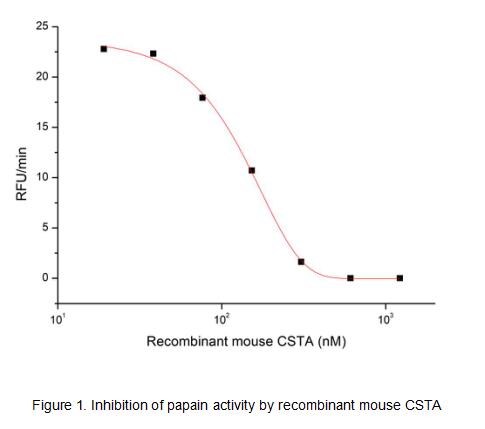Active Cystatin A (CSTA)
Cys-A; STF1; STFA; Stefin A; Cystatin-AS
- Product No.APA476Mu01
- Organism SpeciesMus musculus (Mouse) Same name, Different species.
- Buffer FormulationPBS, pH7.4, containing 0.01% SKL, 5% Trehalose.
- TraitsFreeze-dried powder
- Purity> 90%
- Isoelectric Point5.8
- ApplicationsCell culture; Activity Assays.
- Download Instruction Manual
- UOM 10µg50µg 200µg 1mg 5mg
-
FOB
US$
For more details, please contact local distributors!US$
For more details, please contact local distributors! US$
For more details, please contact local distributors! US$
For more details, please contact local distributors! US$
For more details, please contact local distributors!
ACTIVITY TEST of the Active Cystatin A (CSTA)

Cystatin A (CSTA) is a member of family 1 of the cystatin superfamily. Like Cystatin B, it is an intracellular inhibitor regulating the activities of cysteine proteases of the papain family such as cathepsins B, H and L. For example, immunohistochemical analysis of Cystatin A and cathepsin L is a useful indicator for malignancy in human epidermal keratinocytes. The ratio of cathepsin B and Cystatin A can be used in the differential diagnosis and treatment of patients with prostate carcinoma. The activity of recombinant mouse Cystatin A was measured by its ability to inhibit papain cleavage of a fluorogenic peptide substrate Z-FR-AMC in the assay buffer 50 mM Tris, pH 7.0. Papain was diluted to 500 ug/ml in activation buffer 50 mM Tris, 5 mM DTT, pH 7.0 and incubated at room temperature for 15 minutes. The activated papain was diluted to 100 ug/ml in the assay buffer and 20 ul different concentrations of recombinant mouse Cystatin A (MW: 40.9 KD) was incubated with 20 ul 100 ug/ml papain at 37 ℃ for 10 minutes. Loading 50 µL of the incubated mixtures which were diluted five-fold in assay buffer into empty wells of a plate, and start the reaction by adding 50 µL of 200 µM substrate. Include a substrate blank containing 50 µL of assay buffer and 50 µL of 200 µM substrate. Then read at excitiation and emission wavelengths of 380 nm and 460 nm, respectively, in kinetic mode for 5 minutes. The result was shown in Figure 1 and it was obvious that recombinant mouse Cystatin A significantly decreased papain activity. The inhibition IC50 was <130 nM.
USAGE of the Active Cystatin A (CSTA)
Reconstitute in 10mM PBS (pH7.4) to a concentration of 0.1-1.0 mg/mL. Do not vortex.
STORAGE of the Active Cystatin A (CSTA)
Avoid repeated freeze/thaw cycles. Store at 2-8°C for one month. Aliquot and store at -80°C for 12 months.
STABILITY of the Active Cystatin A (CSTA)
The thermal stability is described by the loss rate. The loss rate was determined by accelerated thermal degradation test, that is, incubate the protein at 37°C for 48h, and no obvious degradation and precipitation were observed. The loss rate is less than 5% within the expiration date under appropriate storage condition.
INCREMENT SERVICES
BCA Protein Quantification Kit
Molecular Mass Marker for Protein
Monoclonal Antibody Customized Service
Polyclonal Antibody Customized Service
Protein Activity Test Experiment Service
Electrophoretic Mobility Shift Assay (EMSA) Experiment Service
Buffer
Lentivirus Packaging Experiment Service
Adenovirus Packaging Experiment Service
Real Time PCR Experimental Service
Spike RBD Protein (S-RBD)
Protein G
Protein A
Related products
| Catalog No. | Organism species: Mus musculus (Mouse) | Applications (RESEARCH USE ONLY!) |
| RPA476Mu02 | Recombinant Cystatin A (CSTA) | Positive Control; Immunogen; SDS-PAGE; WB. |
| RPA476Mu01 | Recombinant Cystatin A (CSTA) | Positive Control; Immunogen; SDS-PAGE; WB. |
| APA476Mu01 | Active Cystatin A (CSTA) | Cell culture; Activity Assays. |
| PAA476Mu01 | Polyclonal Antibody to Cystatin A (CSTA) | WB; IHC; ICC; IP. |
| PAA476Mu02 | Polyclonal Antibody to Cystatin A (CSTA) | WB; IHC; ICC; IP. |
| LAA476Mu81 | FITC-Linked Polyclonal Antibody to Cystatin A (CSTA) | WB; IHC; ICC; IF. |
| LAA476Mu71 | Biotin-Linked Polyclonal Antibody to Cystatin A (CSTA) | WB; IHC; ICC. |
| SEA476Mu | ELISA Kit for Cystatin A (CSTA) | Enzyme-linked immunosorbent assay for Antigen Detection. |
| LMA476Mu | Multiplex Assay Kit for Cystatin A (CSTA) ,etc. by FLIA (Flow Luminescence Immunoassay) | FLIA Kit for Antigen Detection. |
| KSA476Mu01 | ELISA Kit DIY Materials for Cystatin A (CSTA) | Main materials for "Do It (ELISA Kit) Yourself". |

